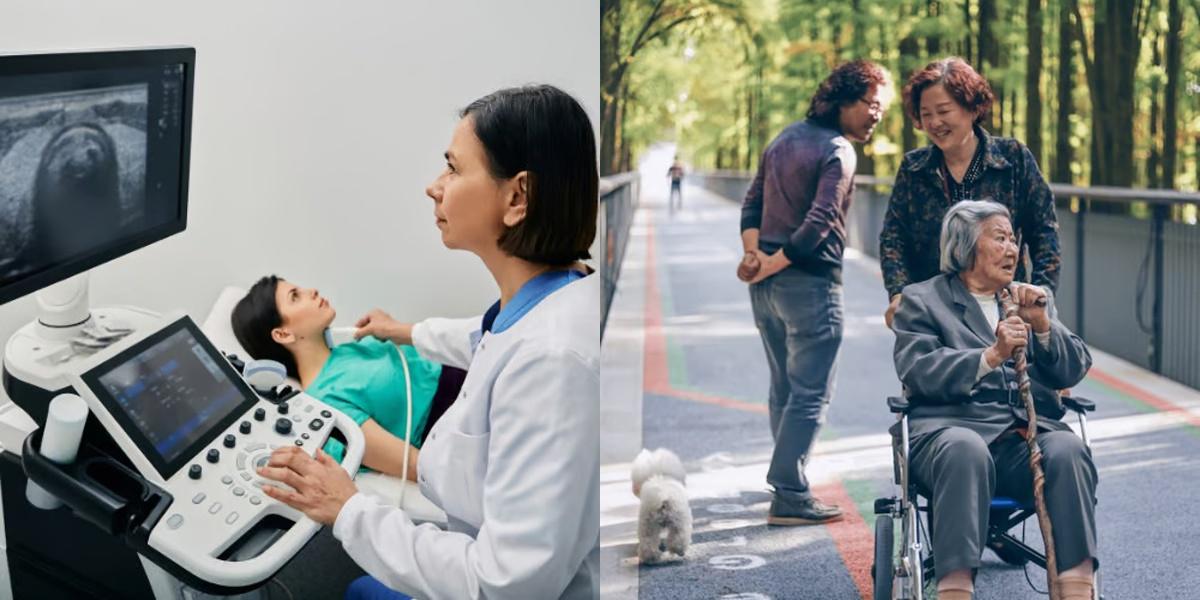Diagnostic Medical Sonographer vs Home Health Aide

Want personalized recommendations?
Let's match you to the right program

Key Points:
- Diagnostic Medical Sonographers use imaging technology to examine patients; Home Health Aides provide basic care and assistance to patients in their homes.
- Diagnostic Medical Sonographers generally earn higher salaries than Home Health Aides.
- Both fields are expected to have positive job growth.
- Diagnostic Medical Sonographers typically require a 2-year associate's degree, while Home Health Aides can often be trained through in-person programs or online courses.
- Diagnostic Medical Sonography training is generally more expensive and takes longer than the training required for Home Health Aides.
In the field of healthcare, there are a variety of career paths to choose from. Two popular choices are becoming a Diagnostic Medical Sonographer or a Home Health Aide. While both careers involve providing care to patients, they have distinct differences in their job descriptions, education and training requirements, and career outlooks.
Article continues after recommendations
Recommended for you
What is a Diagnostic Medical Sonographer and Home Health Aide?
Diagnostic Medical Sonographer A Diagnostic Medical Sonographer, also known as an ultrasound technician, is a healthcare professional who uses specialized equipment to create images of structures inside the human body. These images, known as sonograms or ultrasounds, help doctors diagnose and monitor medical conditions. Diagnostic Medical Sonographers work primarily in hospitals, clinics, and imaging centers. They often interact directly with patients, explaining the procedure, positioning them correctly, and recording the images for interpretation by physicians.
Home Health Aide A Home Health Aide, on the other hand, provides basic healthcare services to patients in their own homes. They assist individuals who are elderly, disabled, or chronically ill with activities of daily living, such as bathing, dressing, and meal preparation. Home Health Aides may also provide companionship and emotional support to their clients. They work under the supervision of a registered nurse or other healthcare professional and may be employed by home healthcare agencies, hospice organizations, or private individuals.
Difference between a Diagnostic Medical Sonographer and Home Health Aide
While both Diagnostic Medical Sonographers and Home Health Aides work in the healthcare industry, there are several key differences between these two professions:
-
Job Setting: Diagnostic Medical Sonographers typically work in hospitals, clinics, or imaging centers, while Home Health Aides provide care to patients in their own homes.
-
Job Duties: Diagnostic Medical Sonographers use ultrasound equipment to create images of internal body structures, while Home Health Aides assist patients with daily tasks such as bathing, dressing, and meal preparation.
-
Level of Patient Interaction: Diagnostic Medical Sonographers work directly with patients, explaining procedures and positioning them correctly, while Home Health Aides provide one-on-one care to patients in their homes, often developing close relationships with their clients.
-
Scope of Practice: Diagnostic Medical Sonographers are highly trained professionals who require specialized knowledge and skills to perform their job effectively. Home Health Aides, on the other hand, provide basic healthcare services and do not require as much formal education and training.
Diagnostic Medical Sonographer vs Home Health Aide: Job Description
Diagnostic Medical Sonographer The job of a Diagnostic Medical Sonographer involves performing ultrasound examinations on patients. They use specialized equipment to capture images of internal body structures, such as organs, blood vessels, and developing fetuses. These images are then interpreted by physicians to diagnose medical conditions. Diagnostic Medical Sonographers must have a strong understanding of anatomy and physiology, as well as the technical skills to operate ultrasound equipment effectively. They often work closely with physicians and other healthcare professionals to provide accurate and timely diagnostic information.
Home Health Aide The primary responsibility of a Home Health Aide is to provide basic healthcare services to individuals in their own homes. This may include assisting with activities of daily living, such as bathing, dressing, and grooming. Home Health Aides may also be responsible for monitoring vital signs, administering medications, and providing emotional support to their clients. They work under the supervision of a registered nurse or other healthcare professional and may be part of a team providing comprehensive care to patients in their homes.
Diagnostic Medical Sonographer vs Home Health Aide: Education and Training
Diagnostic Medical Sonographer To become a Diagnostic Medical Sonographer, individuals typically need to complete an accredited program in diagnostic medical sonography. These programs are available at community colleges, vocational schools, and universities and typically take 2-4 years to complete. Coursework includes anatomy, physiology, patient care, and the principles of ultrasound imaging. After completing their education, individuals may choose to become certified by passing an examination administered by a professional organization such as the American Registry for Diagnostic Medical Sonography (ARDMS).
Home Health Aide The education and training requirements for Home Health Aides vary depending on the state and employer. Some states require individuals to complete a formal training program and pass a competency evaluation to work as a Home Health Aide. These programs are often offered by vocational schools, community colleges, and home healthcare agencies. The curriculum typically includes topics such as personal care, infection control, and basic medical terminology. In some cases, individuals may be able to become a Home Health Aide through on-the-job training, although this is less common.
Get courses selected just for you
Try our powerful search engine
Diagnostic Medical Sonographer vs Home Health Aide: Career Outlook and Salary
Diagnostic Medical Sonographer The career outlook for Diagnostic Medical Sonographers is excellent. According to the Bureau of Labor Statistics (BLS), employment of Diagnostic Medical Sonographers is projected to grow 19 percent from 2018 to 2028, much faster than the average for all occupations. This growth is primarily due to the increasing demand for diagnostic imaging procedures as the population ages. In 2019, the median annual wage for Diagnostic Medical Sonographers was $74,320, with the highest 10 percent earning more than $102,060.
Home Health Aide The career outlook for Home Health Aides is also promising. The BLS projects that employment of Home Health Aides will grow 36 percent from 2018 to 2028, which is much faster than the average for all occupations. This growth is driven by the increasing number of elderly individuals who require assistance with daily activities. In 2019, the median annual wage for Home Health Aides was $25,280, with the highest 10 percent earning more than $31,090.
Final Thoughts
Both Diagnostic Medical Sonographers and Home Health Aides play important roles in the healthcare industry. While Diagnostic Medical Sonographers focus on performing ultrasound examinations and providing diagnostic information to physicians, Home Health Aides provide essential care and support to individuals in their own homes. The choice between these two careers ultimately depends on individual preferences, interests, and educational goals. Both careers offer opportunities for personal satisfaction, professional growth, and making a positive impact on the lives of others.
In summary, Diagnostic Medical Sonographers and Home Health Aides have different job descriptions, education and training requirements, and career outlooks. Understanding these differences can help individuals make an informed decision about which career path is right for them.
Dreambound's educational programs are available in diverse locations. Explore these recommended blogs for a comprehensive examination of the two vocations, including in-depth insights into their prerequisites and guidance on initiating your journey:

Alyssa Jane is part of the customer success team at Dreambound. She works with students, training providers, and employers, helping them have a smooth customer journey. She is also an ESL tutor and Licensed Psychometrician. She is fond of traveling, photography, and discovering new restaurants.


